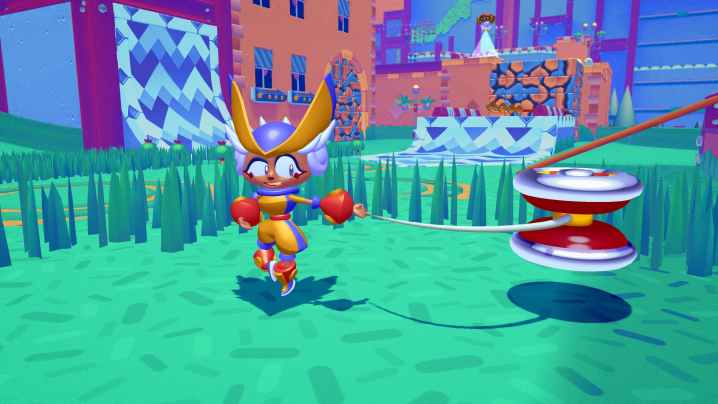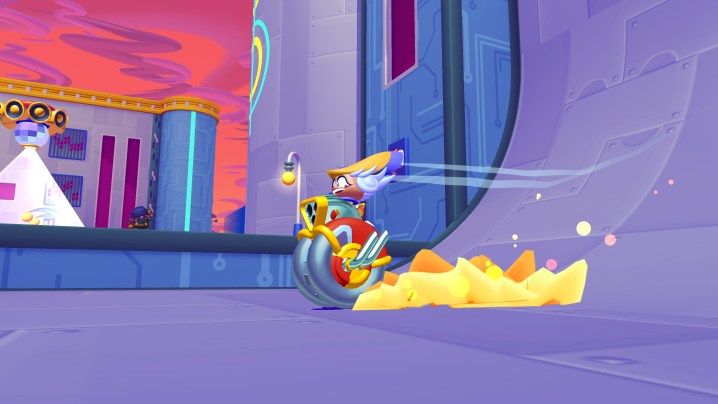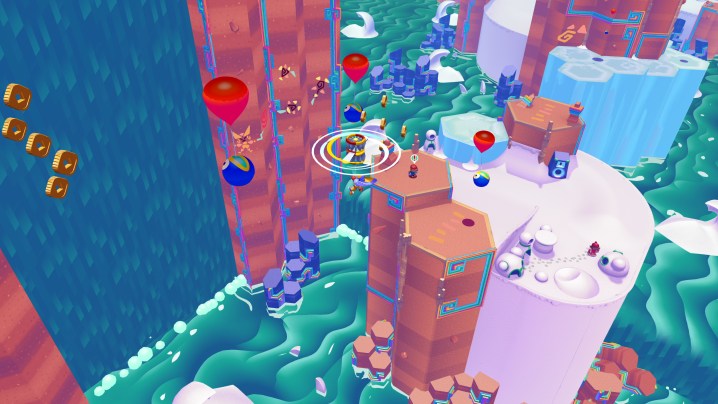“Penny's Big Breakaway isn't one of the genre's greats, but it's a very unique and fun 3D platformer.”
- Unique control scheme works
- Clever yo-yo mechanics
- Encourages gameplay mastery
- Unmemorable characters
- Bad boss fights

At the end of the first world in Penny’s Big Breakaway, the titular character and her sentient, aggressive yo-yo are presented with their first boss-like encounter: a giant rolling ball of penguins. I had to run for my life, swinging with and riding on my yo-yo at pivotal movements so I wasn’t smushed by the ball of a boss, proving to myself that I understood and had started to master its dual-stick control scheme.
While that all probably sounds ridiculous if you’re unfamiliar with Penny’s Big Breakaway, this encounter is where this platforming adventure from some of the developers behind Sonic Mania started to sing. Evening Star nails the game feel, creating a fluid, momentum-driven platforming experience that controls in a unique, yet intuitive manner. No other platformer looks or feels quite like Penny’s Big Breakaway. While this studio’s first outing doesn’t nail things like its narrative or arena-based boss encounters, the developer pedigree behind Penny’s Big Breakaway is evident in this well-designed, surprise-launched platformer.
Moving on from mania
In Penny’s Big Breakaway, players follow the titular character, a performer forced on the run after her sentient Yo-Yo tears off King Eddie’s clothes during an audition. Throughout the adventure, Penny tries to evade Eddie and his compatriots, and meets an eclectic cast of characters along the way. In subtle ways, I could tell that the story of Penny’s Big Breakaway is processing the feelings of the developers who had to “break away” from Sega for unknown reasons, which resulted in this game instead of Sonic Mania 2.

While that meta theme did catch me by surprise, little else did narratively. Penny’s Big Breakaway is a vibrant and colorful game with a large cast of characters, but outside of Penny, none of their designs stand out as that memorable. Some don’t have the simplicity of characters like Sonic or Mario, and each character individually feels like they could have been designed for different games.
Its script certainly got a few chuckles out of me – one of the villains repeatedly calling Penny “Miss Felon” was my favorite running gag – and flavor text throughout each level does give the stages a sense of place. Other than those bright spots, I probably won’t be thinking much about Penny and her friends now that the credits have rolled on Penny’s Big Breakaway.
However, story and characters aren’t why most people come to a game like Penny’s Big Breakaway; how good the platforming feels and how well-designed obstacle course levels are is what they seek. Thankfully, when it isn’t locking players into an arena for a boss fight, Penny’s Big Breakaway nails that.
Expert platforming design
Penny’s Big Breakaway‘s gameplay is all centered around using a magical yo-yo. While you can run and jump like you normally would in a platformer, the yo-yo is used for a variety of different offensive and movement skills. By using the right stick on a controller, you can send out the yo-yo in any direction; this will grab, interact with, or break any objects it comes into contact with. You can also use it to dash or swing in midair by using the right stick while jumping or use the trigger to ride on the yo-yo if an incline or jump gives you enough momentum to move forward. I had to learn to use and mix together all of these abilities to complete linear levels across 11 different worlds.

These unique controls initially take some getting used to; I dashed off the edge of almost every stage in the first world. After some time with the game and being forced to use these skills in high-pressure situations, Penny’s Big Breakaway gets a lot more intuitive. It isn’t as fast-paced as Sonic the Hedgehog, but it incorporates momentum into a robust moveset. There are some pretty wild level shortcuts that even I’ve found by stringing moves together across seemingly impassible gaps.
As players spend more time with and get better at the game, I’m excited to see what other shortcuts or neat platforming tricks are discovered. Penny’s Big Breakaway encourages players to get better in many different ways. For instance, penguin enemies all chase Penny and slow her down after touching her rather than dealing damage; this encourages players to keep moving and to learn how to use the different yo-yo skills to shed themselves of the penguins.
Due to the skateboarding game influences on the yo-yo dual stick controls, Evening Star implemented a combo system. Accrue enough points by the end of a level, and you unlock concept art. Three unique challenges and three collectibles are also strewn about each stage. These tend to require players to show mastery of the movement mechanics, so you get better by completing or obtaining them. Completing the challenges gives you a chance to earn more points in the end-of-level Busker Bonus, while found collectibles can be spent to unlock difficult Star Globe stages that put your skills to the test.

Add in the Time Attack mode, where players can speedrun for the best times and compare their times to other players on a leaderboard, and Penny’s Big Breakaway is a game begging players to get good at it. Having such fun momentum-based gameplay comes with the downside of making Penny’s Big Breakaway less interesting when players have to stop, wait, and deal with level gimmicks that don’t emphasize the best parts of Penny’s moveset. Frequently, this happens in boss fights.
Horrible bosses
The giant penguin ball I mentioned in the intro set the bar high for end-of-world encounters, but unfortunately, none of the others live up to that standard. Many of the boss fights after are more traditional and try to shoehorn the yo-yo mechanics into gimmicky fight-specific challenges, like playing pool with parts of a boss after damaging them.
These arena fights just aren’t nearly as engaging as the normal platforming stages, and poor checkpointing means I had to replay large, repetitive chunks of these fights for a mess-up late in the encounter. Good boss fights recontextualize and enhance the basic mechanics of the game, and the penguin ball encounter toward the start of the game understands this. That makes it all the more unfortunate that most of the other bosses that follow don’t build on that.

Penny’s Big Breakaway was hard to put down, but looking back, frustrations with these boss fights are what caused me to end my play session and come back later. The same goes for stages where they needed more room to play around with all of the gameplay tools as they were too focused on a singular gimmick or obstacle. Those are real momentum-killers for a game where it’s vital to keep moving.
Thankfully, those issues are only speed bumps on the road Penny is rolling down on her sentient yo-yo. When Evening Star Games lets unique platforming mechanics and fluid platforming shine and reinforces them with the scoring system and enemy design, Penny’s Big Breakaway shines. Although I’m not sure that Penny and her yo-yo have the staying power of Sega’s iconic hedgehog, Penny’s Big Breakaway is an easy recommendation to hardcore platforming fans eager to see what the Sonic Mania devs are up to now.
Digital Trends tested Penny’s Big Breakway on PC.




